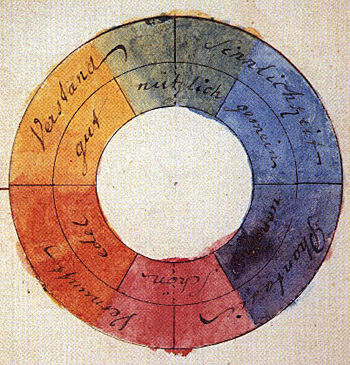3 Things Digital Artists Must Know About Choosing the Right Colors - Color Theory and Psychology Basics
 |
| Color star based on Charles Blanc color star. English Version (Photo credit: Wikipedia) |
 |
| Original Author: Mike Horvath New version by jacobolus (Photo credit: Wikipedia) |
Below are some of the basics of color theory.
1. Additive versus Subtractive Color Theory
In its simplest forms, color theory can be separated into two types: Additive and Subtractive.
Additive color theory states that white light is made up of red, green, and blue light. Red plus blue plus green equals white. In additive color theory, black is the absence of color. This explains why RGB (red, green, blue) is used in video, web design, and any other art medium using lighting. This is important to know, since images that look one way on your computer screen will look an entirely different way when printed.
Subtractive color theory deals with paints and pigments, in which white is the absence of color and pure black is the inclusion of all color. The basic colors in subtractive color theory are yellow, cyan, and magenta, or the compliments of the red, green, and blue. These colors form the basis of many other colors in subtractive color theory. When printing materials in graphic design and print, your color printer uses CYMK, or subtractive color theory, to recreate your design. Once again, this is something to consider when transferring a web or video image to print.
For the purpose of this article, we are discussing subtractive color theory, or color theory based on the properties of pigments, and are using the traditional primary colors of red, yellow, and blue.
2. The Color Wheel
The color wheel is a tool used by artists that expresses complex color relationships through a visual example of a wheel. Color wheels can be as simple as consisting of only primary and complimentary colors, or they can attempt to express literally hundreds of color relationships. The primary colors are red, blue, and yellow and combine to make up the other colors.
Secondary and Tertiary Colors
Secondary colors are made up of the primary colors. Red and yellow equal orange, blue and yellow equal green, and red and blue equal purple. Think about these relationships when you choose colors for your next project. You create tertiary colors by mixing primary colors with secondary colors (example, red plus orange equals red-orange).
Warm, Cool, and Neutral Colors
Warmer colors contain tints of red and yellow, and include red, yellow, orange, red-orange, yellow-orange, some browns, etc. Often, an easy association for warm colors are the colors we associate with fire and the sun. Cool colors, like blues, greens, and purples, are associated with water and ice. Some colors, like pinks and some purples, can exhibit either warm or cool color attributes. Colors like beige and grey are considered neutral tones.
Colors change when placed next to other colors
When red is placed against black, the red pops out, yet when placed against a muted yellow or orange, the same red seems lose its vibrancy. You will see this happen over and over as you choose your color palette. Recently a client asked me to use a certain color palette. When I presented the first web design samples, the client thought I had not used the right colors. It was not until the client did a direct comparison that the client realized that I had used the colors requested. What had changed? Originally the colors were against a white background, emphasizing their vibrancy. When placed against other colors, like yellows and oranges, the brightness disappeared and the project took an overall muted tone.
 |
| Better version of Goethe-Color-Wheel.jpg, sharpened (Photo credit: Wikipedia) |
There are basic psychological attributes assigned to certain colors. For example, red and orange equal excitement, anger, and passion. Blues and purples are often considered calming. Bright yellow has been proven to make babies cry, while a light blue helps them sleep better. Green is associated with nature and the environment. Brown is associated with the earth. Think about these color relationships when choosing the primary colors for your next video, web design, or graphic design project. Does your client have an environmental bent? Then maybe blues and greens would be the right color palette for the project. Are you filming an epic piece about Neanderthals in love? Then some earthy browns and oranges, complimented with yellow, might work. Doing some classic graphic design work, experiment with blacks, whites, and grays, lighting, and saturation.












Comments